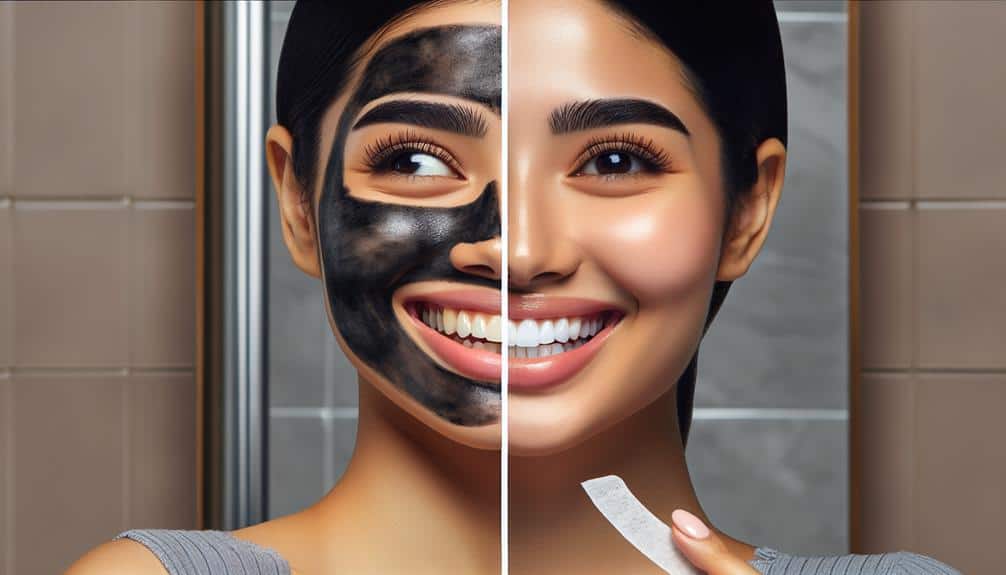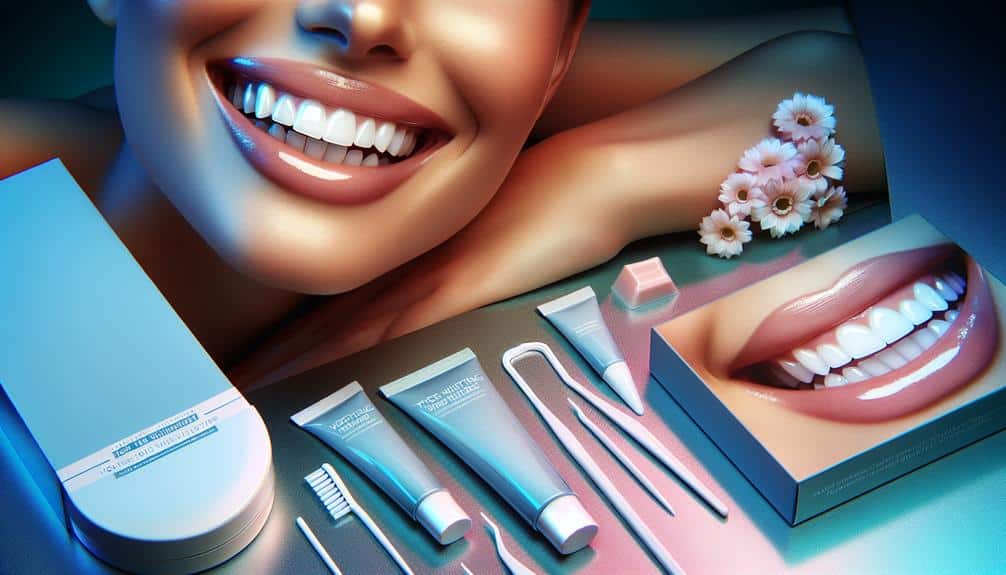When evaluating charcoal teeth whitening strips, it's important to contemplate their effectiveness and safety for enhancing your oral care routine. These strips offer convenience and cost-effectiveness compared to traditional methods, with long-term use showing noticeable improvements if used consistently and according to guidelines. However, factors like frequency of use, adherence to instructions, dietary habits, and proper application technique play a role in achieving best outcomes. Be mindful of potential side effects such as tooth sensitivity and gum irritation, and consult with a dentist before use.
To maximize effectiveness, guarantee thorough and even application while maintaining the recommended application time. Understanding these essential aspects can help you make informed decisions about incorporating charcoal teeth whitening strips into your oral care regimen.
Key Points
- Consistent and proper usage enhances effectiveness.
- Adherence to application guidelines is crucial for results.
- Even coverage without air bubbles ensures efficacy.
- Active ingredients target and remove surface stains effectively.
- Following recommended application time is vital for optimal outcomes.
Charcoal Teeth Whitening Strips Vs Traditional Methods
When comparing charcoal teeth brightening strips to traditional methods, efficacy and safety are important factors to take into account. Charcoal teeth brightening strips are a popular choice due to their ease of use and convenience factor. The application process is straightforward, requiring you to simply place the strips on your teeth for a specified amount of time daily. This simplicity appeals to many individuals seeking a hassle-free brightening solution.
In terms of cost comparison, charcoal teeth brightening strips are often more affordable than traditional methods like professional dental treatments or over-the-counter brightening kits. This cost-effectiveness makes them an attractive option for individuals looking to brighten their teeth without breaking the bank.
When considering long-term results, charcoal teeth brightening strips can provide noticeable improvements in the whiteness of your teeth over time with consistent use. However, following the recommended usage guidelines is crucial to achieve the best results. Overall, charcoal teeth brightening strips offer a convenient and cost-effective way to enhance your smile.
Factors Affecting Charcoal Whitening Strip Results
Factors that influence the effectiveness of charcoal whitening strips include the frequency of use and adherence to usage instructions. Consistency in applying the strips as recommended can greatly impact the final outcome of your whitening experience. Additionally, other personal habits can play a role in determining the results you achieve. Consider these factors:
- Dietary habits: What you eat and drink can affect the success of the whitening strips. Foods and beverages like coffee, tea, or red wine can stain your teeth, potentially counteracting the whitening effects of the strips.
- Brushing technique: Proper brushing techniques are essential to maximize the benefits of charcoal whitening strips. Brushing too hard or too soft can impact the overall whitening results. It's important to follow recommended brushing practices to ensure top strip performance.
Safety Concerns and Charcoal Whitening Strips
Safety considerations are crucial when using charcoal whitening strips to guarantee optimal results and oral health. While charcoal whitening strips are generally safe for most individuals, there are potential side effects to be mindful of. Some users may experience heightened tooth sensitivity or gum irritation when using these strips. It's advisable to follow the instructions carefully and not exceed the recommended usage to minimize these risks.
Furthermore, the long-term effects of using charcoal whitening strips are still being studied. Some concerns have been raised about the abrasive nature of charcoal and its potential to wear down tooth enamel over time. To mitigate this risk, it's advisable to consult with a dentist before starting a charcoal whitening regimen, especially if you have pre-existing dental conditions. Maintaining good oral hygiene practices alongside charcoal whitening strip use can help minimize any potential long-term effects and ensure the best possible outcome for your oral health.
Realistic Expectations From Charcoal Whitening Strips
To set realistic expectations when using charcoal whitening strips, consider the gradual nature of the whitening process and the individual variability in results. It's imperative to understand that the effectiveness of charcoal whitening strips varies from person to person, and results may not be immediate or dramatic. Here are some key points to keep in mind:
- Long Term Results: While some individuals may notice a difference after a few uses, achieving significant whitening results typically requires consistent use over an extended period. Patience is key when aiming for long-lasting improvements in the shade of your teeth.
- Sensitivity Issues: Some users may experience increased tooth sensitivity when using charcoal whitening strips. This sensitivity is usually temporary, but if it persists or becomes uncomfortable, it's crucial to discontinue use and consult with a dental professional.
- Individual Variability: Results can vary based on factors such as initial tooth color, enamel thickness, and adherence to product instructions. Understanding your unique circumstances can help manage expectations and achieve the best possible outcome.
Tips for Maximizing Charcoal Strip Effectiveness
For best results when using charcoal whitening strips, make sure consistent and thorough application following the product instructions meticulously. Proper application technique is vital for maximizing the effectiveness of charcoal strips. Make sure that the strip covers each tooth evenly and reaches all areas that require whitening. Gently press the strip against your teeth to guarantee good contact and avoid air bubbles, which can hinder the whitening process.
In addition to correct application technique, maintaining the recommended time commitment is essential. Most charcoal whitening strips require a specific amount of time to be left on the teeth for best results. Follow the instructions closely and avoid removing the strips prematurely. This allows the active ingredients in the charcoal to work effectively on removing surface stains and discoloration from your teeth.
Frequently Asked Questions
Can Charcoal Teeth Whitening Strips Be Used by Individuals With Sensitive Teeth?
If you have sensitive teeth, managing sensitivity during the whitening process is vital. Check product compatibility to make sure the charcoal teeth whitening strips are suitable for tooth sensitivity. Consult with your dentist for personalized advice.
Are There Any Long-Term Effects on Tooth Enamel From Using Charcoal Whitening Strips?
When using charcoal teeth whitening strips, you might wonder about long-term enamel effects. Despite sensitivity concerns, research shows that when used correctly, these strips can be safe for enamel. Consult your dentist for personalized advice.
Can Charcoal Whitening Strips Effectively Remove Deep Stains From Teeth Caused by Smoking or Coffee Consumption?
To effectively remove deep stains from smoking or coffee, consider alternative methods like professional treatments over charcoal strips. DIY remedies using natural ingredients may help, but consult dental professionals for best results and long-term dental health.
How Often Should Charcoal Whitening Strips Be Used to Maintain Results?
To maintain results, use charcoal whitening strips consistently. For sustained effectiveness, follow usage frequency guidelines. Maintain your whitening routine as recommended for best results. Regularity is key to achieving and preserving desired teeth whitening outcomes.
Are There Any Specific Dietary or Lifestyle Changes That Can Enhance the Effectiveness of Charcoal Whitening Strips?
To enhance the effectiveness of charcoal whitening strips, consider dietary supplements for oral health. Lifestyle changes like reducing sugary foods can support results. Maintain good oral hygiene and stay hydrated for best outcomes.



